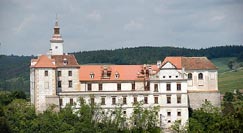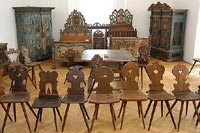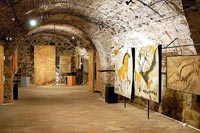From the History of JeviŠovice and the Old Castle

The town Jevišovice is situated in the South part the
Czech-Moravian Hinglands 16 km from Znojmo. It was first mentioned in 1289.
The landmark of the town is the former noble mansion, the so called Old Castle
on the rocky headland on the right side of the Jevišovka river. The castle dates
back to the end of the 15th century when it replaced an older fortress from the
13th century. Its famous owner was the knight Hynek of Kunštát, called "Dry Devil",
a crabbed enemy of the emperor Sigismond and Albrecht of Austria.
In the 1420s Jevišovice was one of bastions of the
Hussitism in South-East Moravia. After its defeat the castle was pulled down.
Historical events of that time are commemorated by a modern memorial in chalice
form on the Žalov hill.
Before World War I,
Jaroslav Palliardi and
František Vildomec
discovered an eneolithic settlement under the rock below the primitive fortress.
The culture of the people who lived there thousands of years ago is called the "Jevišovice culture".
In the Middle Ages the Old Castle was a part of the medieval
town and its fortification. Its gothic face was changed at the end of the 16th
century when it was turned into a Renaissance Chateau with a courtyard and arcades.
It suffered a lot during the 30 year war but in 1686 its new owner, the French Huguenot
Louis Raduit de Souches, the famous defender of Brno against the Swedes, had it repaired
in the baroque style. This appearance of the castle is in principle preserved until today.
Since the middle of the 18th century the castle changed its owner
several times. At the end of the 19th century the former hunting country-house at
the edge of the town was remodelled into a comfortable residence in neo-gothic style.
This New Castle in an English park, however, is not open to the public. At the turn of
the 19th and 20th centuries the gentry stopped living in the Old Castle. In the following
years it was used for farming purposes, in 1945 it was confiscated and was taken into the
hands of the town. For 20 years it underwent a deep renovation and in 1980 it was adapted
for the needs of the Moravian Museum that is in charge of the Castle until today.
Its interiors house archaeological, ethnographic, historical, and literary collections
as well as a worthy collection of historical musical instruments; parts of the collections
are open to the public.
Jevišovice itself was always a Czech town with various crafts
and associations. Its historical centre with buildings from the 18th and 19th centuries,
numerous statues and the St.Joseph-Church from 1830 are worth seeing. The dam constructed
near Jevišovice between 1894 and 1897 to prevent floods is one of the oldest in Middle Europe.
Address:
Jevišovice, district Znojmo
Phone: +420 515 231 141, +420 607 190 990
Opening hours, ticket prices
-
 Storeroom of folk furniture open to the public
Storeroom of folk furniture open to the public
The collection of folk furniture preserved in the Ethnographic Institute of the Moravian Museum and
shown in the Old Castle is one of the most extensive and important in the Czech Lands. It has been accumulated
since the end of the 19th century. It documents the furnishing of village houses in the 19th and 20th centuries,
the decorations of the furniture and bears witness to the artistic abilities of village joiners in Moravia, Bohemia
and other countries. It documents the production of joiner's shops in South and Central Moravia, Bohemian-Moravian
Highlands, at the foothills of Krkonoše mountains, of Orlické mountains or in the region of Cheb. The exhibition is
complemented with examples of folk furniture from Austria and Germany.
-
František Vildomec - Meeting the Venus
In 2006 the Moravian Museum bought one of the largest private collections in this country, the collection
of František Vildomec. It contains several world known unique objects, especially the "Venus" from Hluboké
Mašůvky, the vase from Střelice, etc. The Moravian Museum has moved the collection in its original shape to
the Castle of Jevišovice and has thus created a private "museum in a museum" from the time of the First
Czechoslovak Republic. The collection has been open to the public since May 2011.
-
Dark kitchen in the Castle of Jevišovice
According to the groundplan of the South-Eastern part of the castle, the kitchen dates back most
probably to the Renaissance period (17th century) but it was used until recently. The equipment
of the castle kitchen was more luxurious than in a village house, the vessels were mostly made
of metal - tin or copper, the choice was also larger. For various kinds of meat preparation there
was a selection of grills, spits, skewers, forks and hooks.
-
 Rock paintings
Rock paintings
The exhibition draws from the rich collection of rock art
preserved in the Anthropos Institute of the Moravian Museum and gathered during
the last four decades of the 20th century as a result of Prof. Jelínek's expeditions.
The exhibition is divided into three parts:
-
cave paintings by Upper Palaeolithic hunters (Lascaux, Altamira)
-
rock paintings and engravings from Central Sahara (Fezzan in Libya and Tassili in Algeria)
-
rock paintings from North Australia (the members of the expedition could meet
the authors of the art works and get to know both the technique and the mythology connected with the paintings)
The exhibition shows the replicas of 30 rock paintings and engravings
| How to get to Jevišovice? |
|
The shortest way from Brno to Jevišovice: take E 54 road to Znojmo,
then turn right to Přímětice, Hluboké Mašůvky and Jevišovice.
Map of the surroundings of Jevisovice
E-travel.cz - guide to Prague and the Czech Republic
Last modified:

|

 Storeroom of folk furniture open to the public
Storeroom of folk furniture open to the public Rock paintings
Rock paintings